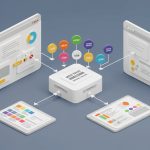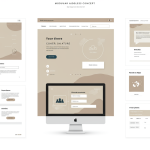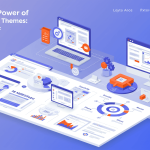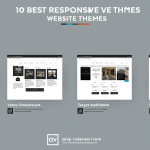
In the ever-evolving landscape of web design, immersive experiences are no longer a luxury—they’re a necessity. As 2025 approaches, cutting-edge website themes leverage 3D graphics, augmented reality (AR), and motion design to captivate users and boost engagement. This comprehensive guide walks you through planning, designing, and implementing an immersive website theme that balances aesthetics, performance, and accessibility.
Why Immersive Website Themes Matter

Traditional flat designs are giving way to interactive, three-dimensional experiences. Users now expect websites to feel alive: parallax scrolling, animated transitions, and AR demos can convey a brand’s story more effectively than static pages. Immersive themes increase session duration, reduce bounce rates, and drive conversions by providing memorable interactions. Learn more about Building Headless CMS-Compatible Website Themes.
Key Technologies: WebGL, AR, and Motion UI
Three core technologies power immersive themes:
- WebGL: A JavaScript API for rendering interactive 3D graphics within any modern browser, without plugins. Ideal for product demos, visualizations, and background scenes.
- Augmented Reality (AR): WebAR frameworks like A-Frame, AR.js, and 8th Wall let you overlay digital content onto real-world views using mobile cameras.
- Motion UI: CSS animations and JavaScript libraries (GreenSock, Anime.js) provide smooth microinteractions and transitions, guiding the user’s attention and reinforcing brand identity.
1. Planning Your Immersive Theme
Begin by defining your goals. Do you want to showcase a product in 3D? Offer an AR try-on experience? Enhance storytelling with animated backgrounds? Sketch user flows and wireframes that highlight core interactions. Prioritize features to avoid performance bottlenecks: if a complex 3D model isn’t central to your message, consider a simplified version or a video fallback.
2. Choosing the Right Framework
Multiple frameworks can accelerate development:
- Three.js: A popular WebGL wrapper with a vast ecosystem of examples and plugins. Great for custom 3D scenes.
- Babylon.js: Offers high-level APIs and physics support for richer interactions, ideal for game-like experiences.
- A-Frame: Built on top of Three.js, A-Frame simplifies AR/VR scene creation with declarative HTML tags.
- Framework Integrations: React Three Fiber (for React), VueGL (for Vue.js), and Angular Three integrate 3D into your favorite SPA frameworks.
3. Optimizing Performance
Heavy assets and animations can slow down load times. Follow these best practices:
- Lazy Loading: Defer non-critical scripts and 3D models until after the main content renders.
- Asset Compression: Use DRACO or glTF compressed models, optimized textures (WebP), and minified scripts.
- Frame Rate Management: Cap animations to 30–60 FPS and pause off-screen updates to conserve CPU/GPU.
- Fallbacks: Provide static images or simplified CSS animations on unsupported devices.
4. Ensuring Accessibility
Immersive features must not exclude users with disabilities. Incorporate these strategies:
- Keyboard Navigation: Ensure interactive elements (buttons, sliders) are focusable and operable via keyboard.
- ARIA Labels: Provide descriptive “aria-label” or “aria-describedby” for 3D controls and toggles.
- Reduce Motion Option: Honor the “prefers-reduced-motion” media query to disable non-critical animations.
- Contrast & Readability: Maintain WCAG AA contrast ratios for text over animated or video backgrounds.
5. Responsive & Mobile-First Design
Mobile devices have constrained resources. Follow a mobile-first approach:
- Viewport-Based Adjustments: Load lighter assets and disable high-resolution textures on small screens.
- Touch Interactions: Replace hover effects with tap gestures and ensure UI elements are large enough for fingers.
- Network Awareness: Use the Network Information API to detect slow connections and reduce asset quality accordingly.
6. Balancing Creativity & Usability
While spectacular visuals can wow users, they should never impede core tasks: navigation, reading content, and conversion. Test your theme with real users in early prototypes. Gather feedback on intuitiveness and load times. Iteration is key—refine visual complexity until it enhances rather than distracts from the user journey.
7. Implementing 3D Assets Efficiently
Working with 3D models demands discipline:
- Poly Count Management: Aim for under 10k triangles for small product models; 30k–50k for hero scenes.
- Texture Atlasing: Combine multiple textures into one atlas to reduce draw calls.
- Level of Detail (LOD): Swap lower-detail models at a distance to save GPU cycles.
- GLTF Format: Use glTF 2.0 for its efficient binary structure and wide browser support.
8. Integrating AR Features
AR brings physical context to your site. Follow these steps:
- Choose a WebAR Framework: AR.js for open-source simplicity, 8th Wall for advanced features, or model-viewer for quick 3D previews.
- Define Markers or Markerless Experiences: Use image markers for quick proofs, or enable markerless AR with plane detection for products on surfaces.
- Optimize Lighting & Shadows: Use environment maps and real-time light estimation for realistic integration.
- Provide Clear Instructions: Guide users through granting camera permission and interacting with AR elements.
9. Designing Microinteractions & Motion
Well-crafted microinteractions add polish and feedback:
- Button Animations: Use subtle scale or color shifts on hover and click to signal responsiveness.
- Scroll-Triggered Effects: Parallax, reveal-on-scroll, and SVG line-drawing animations can highlight content sections.
- Loader Sequences: Replace static spinners with brand-themed animations that inform progress.
- State Transitions: Smoothly animate between theme modes (light/dark) and content filters to maintain context.
10. Testing & Debugging Immersive Themes
Rigorous testing ensures reliability across devices and browsers:
- Cross-Browser Checks: Test WebGL scenes on Chrome, Firefox, Safari, Edge, and mobile browsers.
- Performance Profiling: Use browser DevTools and tools like Lighthouse to monitor FPS, memory usage, and load times.
- Accessibility Audits: Run axe-core or WAVE to catch missing ARIA attributes and color contrast issues.
- User Testing: Conduct remote or in-person sessions to ensure interactions feel natural and intuitive.
11. SEO Considerations for Immersive Themes
Search engines primarily index HTML content, not WebGL scenes. Safeguard your SEO:
- Server-Rendered Content: Render key headings, paragraphs, and calls to action in plain HTML.
- Meta Tags: Write descriptive title tags, meta descriptions, and Open Graph images for social sharing.
- Structured Data: Use JSON-LD to mark up products, events, and reviews to improve rich results.
- Sitemap & Robots.txt: Ensure your site map includes all HTML landing pages and that bots can crawl essential assets.
12. Maintenance & Versioning
Immersive features evolve quickly. Adopt a strategic update plan:
- Modular Architecture: Encapsulate 3D and AR code in separate modules so you can update or rollback without affecting the whole theme.
- Dependency Management: Lock versions for core libraries (Three.js, GSAP) and track updates in a changelog.
- Continuous Integration: Automate testing and performance audits on each commit to catch regressions early.
13. Case Studies: Brands Winning with Immersion
Automotive Showroom: A luxury carmaker used WebGL to let users rotate and customize a 3D model, then launch a WebAR preview to see the car in their driveway. Engagement rose by 65% and test-drive bookings increased by 30%.
Fashion Try-On: An online boutique integrated face-tracking AR so shoppers could virtually try sunglasses and hats. The immersive try-on reduced return rates by 20% and boosted average order value by 25%.
14. Future Trends in Immersive Themes

Looking ahead, these innovations will shape 2025 and beyond:
- WebGPU: Next-gen graphics API offering faster, more complex visuals than WebGL.
- AI-Generated 3D: Tools that auto-create optimized models and textures from simple prompts.
- Persistent WebAR: Shared AR experiences that multiple users can see and interact with simultaneously.
Conclusion
Immersive website themes powered by WebGL, AR, and motion UI represent the next frontier in web design. By carefully planning your theme, optimizing performance, ensuring accessibility, and staying ahead of emerging trends, you can deliver experiences that delight users and drive real business results. Start prototyping today and lead the charge into 2024’s immersive web era.
















No Comments